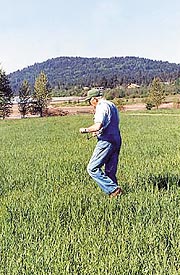
He advanced the timing so that the engine would have little power and not knock. We were going to overhaul the engine when we arrived in Worthington. I followed in our 1950 Ford 1/2-ton pickup, towing 600 feet of drill stem, casing and a water supply tank on a two-wheel trailer. The day following our arrival, Dad said that we'd go ahead and drill the well, and then overhaul the engine before returning home. We ended up drilling the well and driving the rig home before overhauling the engine.
The reason for the urgency to return home was that the birth of my first son, Randy, was overdue and Granddad didn't want to miss being there. On the first day as we were driving north, we passed a man riding a bicycle. We would pass this biker when going up a hill and he would pass us going down hill. For the next three days, this biker stayed right up with us.
It seems like the whole city of Worthington showed up on a daily basis to watch the drilling. We had to build a rope fence around the drill just to keep observers off the drill floor. The local women arrived daily with food for everyone, served on the tailgate of their pickups. We made headlines in the Worthington newspaper with articles, photos and drilling progress reports.
We were contracted to drill this exploratory well to 600 feet that had been doodle bugged (dowsed) by a dowser. The dowser was known to get high blood pressure when he was over oil deposits. The six investors who financed the venture hired a doctor to ride around with the dowser, and when he had high blood pressure, the location was marked and that's where we drilled.

Dad advised the client to get us some used motor oil and add half diesel fuel to it. Then we pumped 150 gallons of oil/diesel down the center of the drill stem and chased that with 25 gallons of water. Dad said to give the cable some slack then shut down and wait. I was reluctant to shut down, but did. Dad went to the truck to take a nap. After waiting about five hours, it was time to go to shut down for the night, Dad said, "Let's check it. If it's not loose now, it will be loose in the morning."
"Yeah, right," I figured. I went over to the rig, let up on the brake and -- low and behold -- the drill stem was loose. We came all the way out of the hole each evening after that. Later I asked Dad, "How did you know the oil/diesel would work?" His reply was, "If I told you, you would know as much as I do." I later figured out that since oil is lighter than water, it penetrates to the top, making the pipe slicker. Try that today and lookout for the EPA.
The well ended up being a dry hole. However, we did encounter a depression in the glacial till much deeper than normal for that area. The clients wanted us to return later with a larger rig and go deeper. They never came up with the money, and, needless to say, we never went back.


Report Abusive Comment